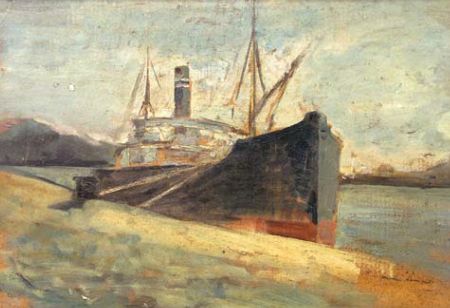Nicolae Vermont was one of the masters of Romanian Realist painting and one of the most interesting painters, muralists and draftsmen of his time, as many viewed him as an associate of Stefan Luchian. He was a prolific and surprisingly inovative artist, with a strong, original style and manner and quite a broad choice of subjects, but he preffered landscapes and still lifes.
Born on October 10th 1866 in Bacau, in a Jewish family - he would much later convert to Orthodoxism - he started working at first in 1884 for the prestigious Universul newspapers. At the same time he enrolled at the Fine Arts Academy in Bucharest, where he had the great opportunity of studying under Thedor Aman, who would prove to be a great influence and example for the much younger artist. After graduating in 1886 Vermont completed his studies in Munich, with the help of Nicolae Grigorescu.
.jpg)
Beach at Dieppe (1929)
It was here, in Munich, far away from his country, that he decided joining Tinerimea Artistica, an important and prestigious cultural association of young artists, who rejected all Academism and formality, thus bringing together the likes of Luchian, Arthur Verona, Marius Bunescu, Alexandru Satmari, Jean Al Steriadi and others. In 1896, together with Luchian, Artachino and Bogdan-Pitesti, Vermont was one of the founder of the Salonul Independentilor, the Romanian version of the Salon des Refuses. It was a key movement for the further developpement of national art, although it caused quite a stir in the beginning.
At the same time Nicolae Vermont was slowly but surely creating his own personal style, strongly marked by Realism. At the same time he started using some rather unusual themes - for that era - inspired by the life of the poor, the rejected, social failures, unemployed. He was surprisingly popular and successful, even if this type of artworks weren't too much in fashion, in the beginning. He would have several other exhibitions over the next years, with great success, and in 1898 he was also one of the founder of the Ileana Society, meant to promote the new art and young artists.

Anchored Ship
Nicolae Vermon also painted several churches and provided the interior decorations for several important places in Bucharest, such as the ceilings of the Kalinderu and Cantacuzino Palaces. It is a shame that a large part of the works of this prolific, huge artist, was destroyed in 1944 by German bombings. But even if many masterpieces were forever lost, a great deal of his artworks are today in museums and galleries all over Romania, but also in prestigious private collections.
The artist was one of the most interesting and influential voices of his generation, marking and changing the landscape of Romanian painting, as he always tried to offer something more, something new, to challenge rules and themes, to offer the viewer an artistic experience that was strikingly beautiful and shockingly fresh and alive. A great master and a great name.
Foto : wikipedia.org

































